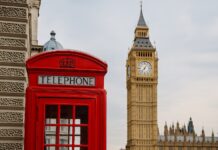From the haunting sonnets of Shakespeare to the radiant brushstrokes of Turner, English literature and art have evolved through centuries of creativity, emotion, and rebellion. This in-depth exploration of nine extraordinary figures reveals how their ideas and innovations transformed not just their fields but the very essence of how we perceive beauty, society, and the human condition. Their legacies continue to illuminate the cultural landscape of the modern world.
Introduction
English literature and art have long stood as twin beacons of intellectual and emotional expression, reflecting the spirit of their age and transcending the boundaries of time. Over centuries, England has produced a remarkable lineage of poets, novelists, playwrights, and painters whose works continue to shape the global imagination. From medieval storytellers to modernist visionaries, each era has produced creative minds who have redefined storytelling, emotion, and aesthetics in their own revolutionary ways.
At their core, these artists and writers shared one timeless ambition — to interpret life through the lens of art. Whether it was Geoffrey Chaucer capturing the diversity of medieval society, Jane Austen dissecting human behaviour through irony, or J.M.W. Turner transforming landscapes into emotional experiences, each contributed uniquely to humanity’s cultural tapestry. Collectively, their works mirror the moral struggles, political revolutions, and spiritual quests that have defined England’s journey through history. To understand their contributions is to understand the soul of English civilisation itself — one built upon the harmony of intellect and imagination.
1. William Shakespeare – The Immortal Bard of Avon
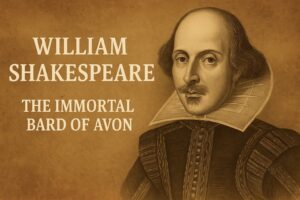
Legacy and Significance
William Shakespeare (1564–1616) stands unparalleled in the pantheon of world literature. Known as the “Bard of Avon,” his plays and poetry have influenced nearly every major language, culture, and art form. He captured the complexities of the human psyche and distilled them into timeless characters and unforgettable verses. His influence transcends literature, extending into psychology, philosophy, and even politics.
Key Contributions
- Dramatic Mastery: Shakespeare revolutionised English drama with plays like Hamlet, Macbeth, Othello, and King Lear. His ability to blend poetic elegance with psychological realism redefined theatrical art.
- Language Innovation: He expanded the English vocabulary by introducing over 1,700 new words and countless idioms that remain in daily use.
- Humanistic Vision: His works delve into the eternal themes of love, betrayal, ambition, fate, and morality, offering insights that remain relevant centuries later.
- Genre Versatility: From comedies to tragedies, histories to romances, he mastered every form of dramatic storytelling.
Influence
Shakespeare’s influence is boundless. His characters, such as Hamlet, Lady Macbeth, and King Lear, embody universal emotions and dilemmas, making them subjects of endless reinterpretation. Every generation of writers, from Charles Dickens to James Joyce, has drawn inspiration from his artistry. His legacy extends to cinema, where adaptations continue to breathe new life into his timeless words. In essence, Shakespeare remains the moral and linguistic architect of English thought.
2. Geoffrey Chaucer – The Father of English Literature

Legacy and Significance
Geoffrey Chaucer (c. 1343–1400) is rightly hailed as the “Father of English Literature.” Living in a period when Latin and French dominated the literary world, Chaucer chose to write in English, giving voice to the people. His masterpiece, The Canterbury Tales, stands as a vivid chronicle of medieval English life, combining humour, morality, and social realism in ways that were centuries ahead of their time.
Key Contributions
- Language Pioneer: Chaucer’s use of Middle English transformed it into a literary language of sophistication and artistry.
- Social Commentary: Through The Canterbury Tales, he portrayed a cross-section of English society—from knights and merchants to nuns and millers—each reflecting human virtues and follies.
- Rhythmic Innovation: He introduced iambic pentameter and narrative verse forms that influenced poets from Shakespeare to Alexander Pope.
- Moral Insight: Beneath his humour lay a profound moral philosophy exploring faith, greed, and the human condition.
Influence
Chaucer’s legacy is not merely literary but cultural. He provided one of the first accurate portraits of English society, merging realism with poetic grace. His influence echoes in modern storytelling, where irony, character depth, and satire remain vital tools. Chaucer’s decision to write for ordinary people rather than elites marked a democratic turn in literature—one that made art a mirror for all humanity.
3. John Milton – The Voice of Freedom and Faith

Legacy and Significance
John Milton (1608–1674) stands as a symbol of moral conviction and intellectual courage. A poet, polemicist, and political thinker, he lived through turbulent times that saw England’s monarchy fall and rise again. His magnum opus, Paradise Lost, transformed the biblical tale of humanity’s fall into an epic exploration of rebellion, redemption, and divine justice.
Key Contributions
- Epic Poetry: Paradise Lost fused classical epic form with Christian theology, exploring profound questions of good and evil, obedience and free will.
- Political Advocacy: Milton’s prose works, like Areopagitica, became cornerstones of the modern concept of free speech and individual conscience.
- Linguistic Majesty: His command of blank verse set new standards of poetic expression, combining grandeur with philosophical depth.
- Moral and Theological Inquiry: Milton wrestled with the dilemmas of divine justice and human agency, themes that still resonate in theological and political debates.
Influence
Milton’s fusion of art and ideology inspired poets like Wordsworth and Shelley, who viewed him as a prophet of moral independence. His writing helped shape Enlightenment thought, influencing democratic ideals across Europe and America. In literature and politics alike, Milton stands as a beacon of integrity—a man who believed that truth and freedom are the twin pillars of human progress.
4. Jane Austen – The Architect of Modern Realism
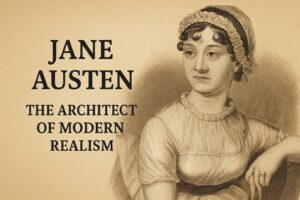
Legacy and Significance
Jane Austen (1775–1817) revolutionised the English novel by merging social observation with wit and emotional intelligence. Living in an era that confined women to domestic roles, she crafted heroines who balanced independence with integrity. Her novels continue to enchant readers for their humour, moral insight, and timeless reflections on love, class, and social mobility.
Key Contributions
- Social Realism: Novels like Pride and Prejudice and Emma dissect the nuances of 18th-century society with sharp irony and empathy.
- Psychological Depth: Austen’s characters—Elizabeth Bennet, Mr. Darcy, Anne Elliot—exemplify the complexities of human emotion and self-awareness.
- Feminist Subtext: Without overt rebellion, she questioned gender inequality and the economic limitations imposed on women.
- Narrative Style: Her use of free indirect discourse revolutionised storytelling, allowing readers intimate access to her characters’ inner thoughts.
Influence
Austen’s literary influence extends from the Brontë sisters to Virginia Woolf and beyond. Her wit and subtle feminism laid the groundwork for modern psychological fiction. Films, television series, and countless adaptations keep her works alive, proving that Austen’s exploration of love and identity remains as relevant today as it was two centuries ago.
5. Charles Dickens – The Humanitarian of the Victorian Age
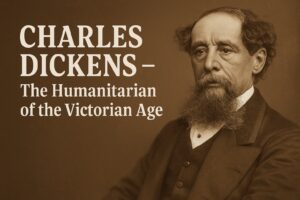
Legacy and Significance
Charles Dickens (1812–1870) emerged as the conscience of the Victorian era. His novels not only entertained but also exposed the dark realities of industrial England—poverty, child labour, and class inequality. A master storyteller, he combined humour, pathos, and moral clarity in a body of work that continues to influence literature and social thought.
Key Contributions
- Social Commentary: Works such as Oliver Twist, Bleak House, and Hard Times highlighted the struggles of the poor and the hypocrisy of the privileged.
- Characterisation: Dickens created some of literature’s most memorable figures—Ebenezer Scrooge, Tiny Tim, and David Copperfield—each embodying moral lessons.
- Serialisation: By publishing his novels in instalments, Dickens made literature accessible to the masses, revolutionising the reading culture.
- Emotional Engagement: His mastery of sentiment created empathy and inspired philanthropic reform.
Influence
Dickens’s writing transcended entertainment—it became activism. His depictions of urban life stirred public awareness and influenced legislative reforms on education and child welfare. Writers like George Orwell and John Steinbeck inherited his tradition of social critique. Through words, Dickens gave voice to the voiceless and turned storytelling into a force for justice.
6. William Wordsworth – The Spirit of Romanticism
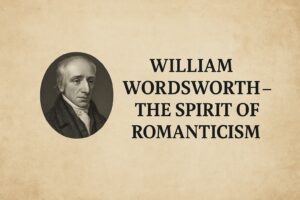
Legacy and Significance
William Wordsworth (1770–1850) redefined poetry through his belief that emotion and imagination were as vital as reason and intellect. A founding figure of the Romantic movement, he championed the spiritual power of nature and the purity of personal experience. His poetry sought to reconcile man and nature, reason and feeling, individual and universal.
Key Contributions
- Nature as Revelation: In poems like Tintern Abbey and The Prelude, Wordsworth portrayed nature as a living, moral presence that shapes the human soul.
- Democratic Poetics: He broke from elitist traditions, using simple language to capture profound emotion, making poetry accessible to all.
- Psychological Introspection: His exploration of memory and consciousness anticipated modern psychological writing.
- Romantic Philosophy: Wordsworth’s “spots of time” theory celebrated fleeting yet transformative moments of awareness.
Influence
Wordsworth’s legacy endures in both literature and environmental philosophy. His reverence for nature influenced poets such as Keats, Shelley, and even American transcendentalists like Emerson and Thoreau. He taught generations to find spiritual fulfilment in simplicity and natural beauty, reshaping poetry into a medium for emotional truth.
7. Virginia Woolf – The Modernist Visionary

Legacy and Significance
Virginia Woolf (1882–1941) transformed modern fiction through her radical experiments with form, time, and consciousness. A key figure in the Bloomsbury Group, she brought feminist insight and psychological nuance to 20th-century literature. Her works bridged the personal and the philosophical, revealing the intricacies of identity, gender, and perception.
Key Contributions
- Narrative Innovation: Woolf’s use of stream-of-consciousness in Mrs Dalloway and To the Lighthouse redefined narrative structure and reader engagement.
- Feminist Thought: In A Room of One’s Own, she articulated the need for women’s independence and intellectual freedom.
- Psychological Exploration: Her writing captured the flow of inner life, presenting thought as fluid and fragmented.
- Cultural Critique: Woolf challenged patriarchy, class privilege, and the rigidity of traditional values.
Influence
Virginia Woolf’s influence spans literature, feminism, and psychoanalysis. She opened the path for writers like James Joyce and Margaret Atwood, and her essays remain cornerstones of feminist theory. Her introspective artistry continues to inspire both academic inquiry and creative expression across the world.
8. J.M.W. Turner – The Painter of Light and Motion
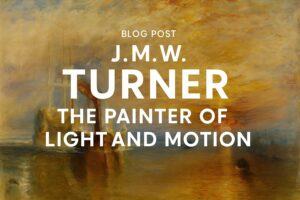
Legacy and Significance
Joseph Mallord William Turner (1775–1851) stands as one of the most visionary figures in British art. His fascination with light, atmosphere, and motion revolutionised landscape painting and anticipated modern abstract styles. Turner transformed natural scenes into emotional symphonies, capturing the sublime power of the world around him.
Key Contributions
- Technical Brilliance: Turner’s mastery of oil and watercolour enabled him to experiment with texture, colour, and luminosity.
- Emotive Landscapes: Works like The Fighting Temeraire and Rain, Steam and Speed merge natural beauty with the forces of modernity.
- Rebellion Against Realism: He prioritised feeling over form, turning landscapes into emotional experiences rather than mere depictions.
- Impressionistic Vision: His approach laid the groundwork for Impressionism, influencing Monet and other European artists.
Influence
Turner’s work changed the trajectory of visual art. His radical abstraction shocked contemporaries but liberated future generations. The play of light in his paintings echoes the Impressionists’ work, while his emotional intensity foreshadows Expressionism. Turner’s art remains a reminder that beauty lies not just in clarity but in the mystery of perception.
9. William Blake – The Mystic and the Revolutionary

Legacy and Significance
William Blake (1757–1827) defied every convention of his time. A poet, painter, and visionary, he sought to merge art and spirituality into one transcendent experience. His prophetic works explored the tension between innocence and corruption, freedom and repression, heaven and hell. To Blake, imagination was divine—the path to truth.
Key Contributions
- Fusion of Art and Poetry: In Songs of Innocence and Experience, Blake combined verse and illustration, pioneering the concept of illuminated printing.
- Visionary Symbolism: His imagery—angels, flames, and cosmic landscapes—expressed spiritual truths through symbolic art.
- Radical Philosophy: Blake rejected industrial materialism and institutional religion, advocating for imagination as a sacred force.
- Artistic Independence: Working largely in isolation, he crafted a unique style that bridged Romanticism and mysticism.
Influence
Blake’s visionary art influenced the Pre-Raphaelite Brotherhood, Surrealists, and modern countercultural movements. His blending of text and image anticipated graphic novels and multimedia storytelling. Today, Blake is celebrated as a prophet of creative freedom—an artist who turned imagination into a form of spiritual resistance.
The Fusion of Literature and Art in English Culture
The relationship between English literature and art is one of mutual inspiration. Writers and artists often drew upon shared themes—nature, morality, beauty, and human emotion. Turner’s landscapes resonate with Wordsworth’s poetry; Blake’s illuminated verses reflect Shakespearean drama and Miltonic grandeur. Together, they illustrate how visual and literary arts evolved side by side, enriching each other’s language and meaning.
Shared Themes
- Human Nature: Both literature and art probe into love, ambition, guilt, and redemption.
- The Power of Nature: From the Lake Poets to Turner’s canvases, nature remained a moral and spiritual presence.
- Freedom and Rebellion: Milton, Woolf, and Blake alike championed intellectual and creative liberty.
- Faith and Doubt: Each generation wrestled with divine and human order, questioning morality and truth.
English creativity thus represents not separate disciplines but a unified quest—to interpret life and transcend it through art.
The Enduring Relevance of English Masters
What makes these figures truly timeless is their ability to speak to every era. Chaucer’s irony still echoes in modern satire; Austen’s social critique remains pertinent in discussions on gender; Woolf’s explorations of consciousness prefigure today’s psychological fiction. Their ideas continue to shape education, inspire artists, and influence global narratives.
The universality of their works lies in their humanity—they write and paint about love, suffering, hope, and beauty, themes that never lose relevance. In an age dominated by digital expression, revisiting their creations reminds us of the enduring power of authenticity and thought.
Frequently Asked Questions (FAQs)
1. Why is William Shakespeare considered the greatest English writer?
William Shakespeare is regarded as the greatest English writer because of his unparalleled ability to capture the universal essence of human experience through language. His plays and sonnets explore love, ambition, jealousy, power, and mortality with a psychological depth unmatched in literary history. Shakespeare transformed theatre into an art form of philosophical and emotional exploration. He invented over 1,700 English words and countless phrases that remain in use today. Moreover, his works transcend time and culture—performed globally and translated into every primary language. From Hamlet to Romeo and Juliet, Shakespeare’s storytelling fuses poetry with moral insight, making him not just a dramatist but the architect of the modern imagination. His influence extends into psychology, politics, film, and philosophy, ensuring his position as a timeless cultural icon.
2. How did Geoffrey Chaucer shape the English language?
Geoffrey Chaucer revolutionised English literature by writing in Middle English when Latin and French were the dominant literary languages. Through The Canterbury Tales, he elevated English from a vernacular dialect to a respected literary medium. Chaucer captured the richness of medieval society by depicting pilgrims of diverse classes and professions, combining realism with humour and moral reflection. His rhythmic innovations—especially his use of iambic pentameter—laid the foundation for future English poetry. Beyond technical mastery, Chaucer gave English readers a sense of national identity by portraying their language and lives with authenticity and pride. He demonstrated that English could express the full range of human experience—from sacred devotion to earthly folly. His influence extends through every era of English writing, inspiring Shakespeare, Dryden, and even contemporary novelists who use wit, irony, and social observation to tell enduring human stories.
3. What makes John Milton’s work unique?
John Milton’s work stands apart for its fusion of poetry, theology, and political philosophy. His masterpiece Paradise Lost reimagines the biblical story of humanity’s fall as an epic of cosmic rebellion and moral struggle. Milton’s Satan, both villain and tragic hero, introduced psychological complexity to literature centuries before Freud. His command of blank verse gave English poetry a grandeur and rhythmic power rivalled only by classical epics. Yet Milton was not only a poet—he was a political thinker who defended freedom of speech and conscience in Areopagitica, a revolutionary essay that still influences democratic thought. His commitment to truth, even when it defied authority, made him a symbol of intellectual independence. Milton’s legacy endures in modern literature, philosophy, and civil liberties, reminding the world that artistic greatness often arises from moral conviction and fearless inquiry.
4. How did Jane Austen redefine the English novel?
Jane Austen redefined the English novel by merging humour, moral insight, and social commentary into narratives of everyday life. Before Austen, fiction was often melodramatic or moralistic. She introduced realism—stories rooted in ordinary experiences, shaped by class, gender, and emotion. Through works like Pride and Prejudice and Emma, Austen dissected the subtle negotiations of love and marriage within a rigid social order. Her heroines, such as Elizabeth Bennet and Anne Elliot, displayed independence of thought and emotional intelligence rare for their time. Stylistically, she pioneered free indirect discourse, allowing readers to experience a character’s thoughts through a third-person narrator—a technique that would later influence James Joyce and Virginia Woolf. Austen’s novels remain timeless because they examine the complexities of human relationships, self-awareness, and moral integrity. She elevated domestic fiction into high art, transforming how we read, empathise, and understand society.
5. What was Charles Dickens’s role in social reform?
Charles Dickens was not only a novelist but also a social reformer who used fiction to expose the injustices of Victorian society. His vivid depictions of poverty, child labour, and industrial exploitation awakened the conscience of an empire. In novels like Oliver Twist and Bleak House, Dickens humanised the struggles of the poor, transforming them from statistics into characters with hopes and dreams. His works reached a vast audience through serial publication, bridging class divides and mobilising public empathy. Dickens’s influence extended beyond literature—his portrayals of orphanages, workhouses, and debtors’ prisons inspired legislative reforms in education and labour conditions. His storytelling combined sentiment, humour, and moral urgency, proving that art could drive social change. Today, Dickens is remembered as both a literary genius and a humanitarian who turned storytelling into a tool for justice and compassion.
6. Why is Virginia Woolf a cornerstone of modern literature?
Virginia Woolf stands as a cornerstone of modern literature for her revolutionary narrative techniques and feminist vision. Rejecting conventional plot-driven storytelling, Woolf introduced the stream-of-consciousness style, capturing the fluid, non-linear flow of human thought. In novels like Mrs Dalloway and To the Lighthouse, she portrayed the inner lives of ordinary individuals with extraordinary sensitivity. Her essays, especially A Room of One’s Own, became foundational texts in feminist literary criticism, advocating for women’s intellectual and creative autonomy. Woolf challenged patriarchal norms, exploring how gender, time, and class shape perception and identity. Her poetic language and introspective realism redefined the possibilities of fiction, influencing generations of writers from Toni Morrison to Margaret Atwood. More than a literary innovator, Woolf remains a moral and psychological voice for authenticity, equality, and the boundless potential of human consciousness.
7. How did William Blake influence future generations of artists?
William Blake’s legacy extends far beyond his lifetime, influencing poets, painters, and musicians across centuries. A visionary who merged art and poetry, Blake believed imagination was the divine essence of humanity. His illuminated books, such as Songs of Innocence and Experience, combined verse and hand-painted illustrations to explore themes of purity, corruption, and redemption. His radical critique of industrialism and institutional religion made him a precursor to both Romanticism and modern countercultural thought. Artists from the Pre-Raphaelites to the Surrealists revered his symbolic imagery and spiritual rebellion. In the 20th century, Blake’s works inspired political movements, musical compositions, and graphic storytelling. His insistence that “all religions are one” and that “imagination is eternity” continues to inspire creatives who seek freedom beyond convention. Blake’s art endures as a bridge between mysticism and modern artistic expression—a timeless call to see the world through the soul’s eye.
Conclusion
English literature and art have thrived because of individuals who dared to dream differently. From Chaucer’s earthy tales to Woolf’s psychological modernism, and from Blake’s mystic visions to Turner’s luminous canvases, these figures embody the evolution of creativity itself. Their works remind us that art is both mirror and lamp—reflecting the world while illuminating it.
Their legacy is not confined to history books or museums. Each reading of Shakespeare, each viewing of Turner, each contemplation of Austen’s irony renews their relevance. They speak across centuries, teaching us to think, to feel, and to see. Through their words and images, they ensure that English culture remains not merely a chapter in history, but a living, breathing testament to the power of imagination.







